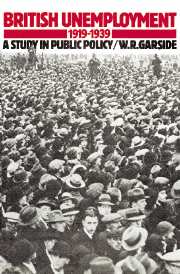Book contents
- Frontmatter
- Contents
- List of tables
- Preface
- Acknowledgements
- PART I INTRODUCTION
- PART II THE LABOUR MARKET UNDER STRAIN
- PART III THE INTERNATIONAL CONTEXT
- 5 On and off gold: unemployment, monetary policy and the exchange rate
- 6 Trade, tariffs and the stimulation of exports
- 7 Men, money and markets: the ‘Empire solution’ to unemployment, 1919–1931
- PART IV STRUCTURAL UNEMPLOYMENT, INDUSTRY AND THE REGIONS
- PART V MACROECONOMIC POLICY OPTIONS: THEORY AND PRACTICE
- Bibliography
- Index
6 - Trade, tariffs and the stimulation of exports
Published online by Cambridge University Press: 21 September 2009
- Frontmatter
- Contents
- List of tables
- Preface
- Acknowledgements
- PART I INTRODUCTION
- PART II THE LABOUR MARKET UNDER STRAIN
- PART III THE INTERNATIONAL CONTEXT
- 5 On and off gold: unemployment, monetary policy and the exchange rate
- 6 Trade, tariffs and the stimulation of exports
- 7 Men, money and markets: the ‘Empire solution’ to unemployment, 1919–1931
- PART IV STRUCTURAL UNEMPLOYMENT, INDUSTRY AND THE REGIONS
- PART V MACROECONOMIC POLICY OPTIONS: THEORY AND PRACTICE
- Bibliography
- Index
Summary
In their faltering efforts to understand the complex origins and nature of the unemployment problem confronting them, interwar governments remained wedded to one essential belief: that its emergence was primarily the result of the failure of Britain's traditional export industries. From that perspective, the natural corrective to the unemployment crisis appeared to lie in a revival of Britain's export performance by whatever means seemed most appropriate. As subsequent chapters will indicate, lower unit wage costs and an improvement in the structure and efficiency of the staple export trades were regarded with varying degrees of enthusiasm during the twenties as valuable means of improving Britain's fortunes in international trade. Likewise, as we have seen, ‘sound money’ and stable exchange rates were tantamount in the official mind to a positive employment policy inasmuch as they were considered the prerequisite of a lasting trade revival.
To the authorities, however, it seemed sheer folly not to take more direct steps to restore Britain's trading supremacy. Whether that supremacy was or ever would be in reach was not an issue which troubled governments unduly. Attempting to reduce the prevailing pattern of industrial unemployment through expanded trade was after all a far less fearsome prospect than trying to create new jobs through vigorous and untested schemes of national investment.
- Type
- Chapter
- Information
- British Unemployment 1919–1939A Study in Public Policy, pp. 140 - 178Publisher: Cambridge University PressPrint publication year: 1990



